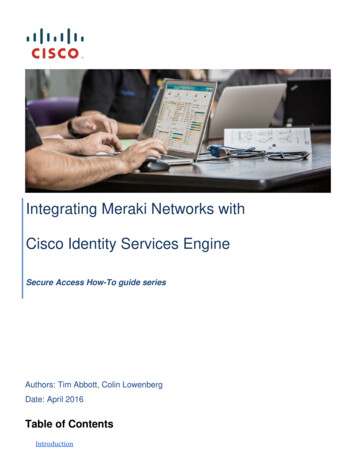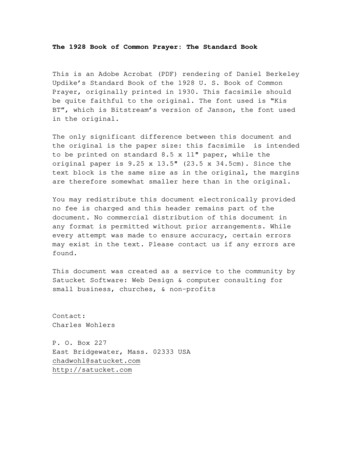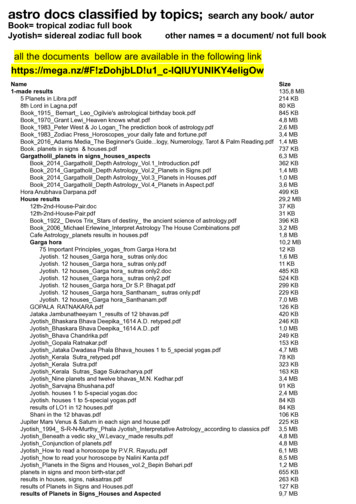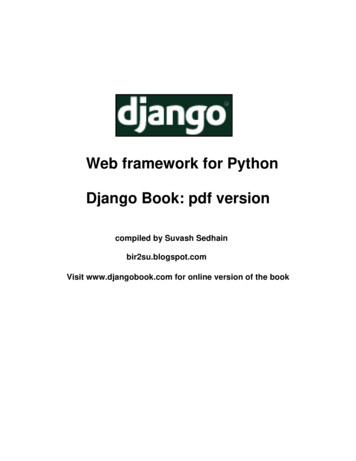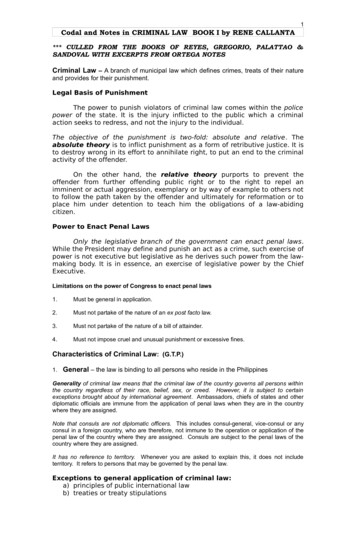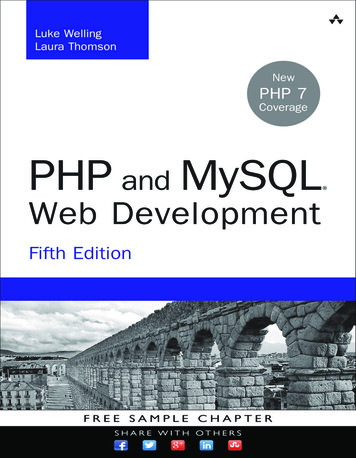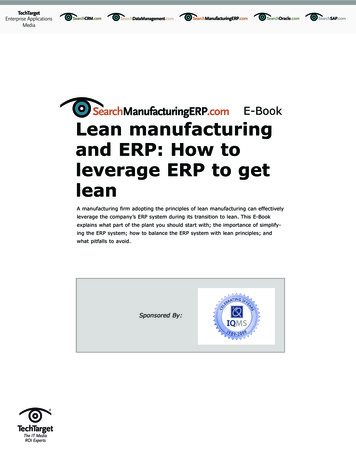
Transcription
TechTargetEnterprise ApplicationsMediaE-BookLean manufacturingand ERP: How toleverage ERP to getleanA manufacturing firm adopting the principles of lean manufacturing can effectivelyleverage the company’s ERP system during its transition to lean. This E-Bookexplains what part of the plant you should start with; the importance of simplifying the ERP system; how to balance the ERP system with lean principles; andwhat pitfalls to avoid.Sponsored By:
Lean manufacturing and ERP: How to leverage ERP to get leanTable of ContentsE-BookLean manufacturingand ERP: How toleverage ERP to getleanTable of Contents:For the lean manufacturer, ERP plays a vital roleHow running ERP in a lean manufacturing environment can improve the bottom lineWhen using ERP to go lean, experts advise starting smallAvoiding the pitfalls of configuring your ERP system for a lean environmentResources from IQMSSponsored by:Page 2 of 14
Lean manufacturing and ERP: How to leverage ERP to get leanFor the lean manufacturer, ERP plays a vital roleFor the lean manufacturer, ERP plays a vital roleBy Jean Thilmany, SearchManufacturingERP.com ContributorIn order to simplify manufacturing and reduce inventory levels, some proponents of the lean manufacturing enter-prise recommend the elimination of the ERP system.However, at most, a manufacturer’s ERP system should be simplified.“There’s a huge part of your business that has to go on, whether you’re lean or not,” says Jim Shepherd, seniorvice president of research at AMR Research. “You still have to do general ledger and accounts payable, and youhave to purchase and receive things and take customer orders.”According to Shepherd, “The reality is, unless you’re running a fairly small or simple organization without a complexproduct, it’s not practical to run a manufacturing company without a dedicated business application. I could be run-ning the leanest place around, but I’ll still need an ERP system, even if I don’t use it out on the shop floor.”Introducing the principles of lean manufacturing principles to an organization means training employees as well aslaying out production lines anew. And ERP has no role in these types of changes.But ERP does have a vital role to play in analyzing existing business practices and potentially restructuring them tooperate in a lean manufacturing environment. After all, according to Shepherd, the only way to find areas that needimprovement and then make those improvements is by tracking and analyzing current manufacturing processes—which can be done in ERP.The good news is that, beyond day-to-day business operations, lean principles such as continuous process improvement are also supported by ERP. “ERP organizes the information you need about products, production, facilities,resources and demand,” Shepherd says. “You need this [information] to implement lean, so having it organized in asingle place of reference is very valuable.”Manufacturers will find the best payoff from implementing lean manufacturing principles by combining the predictivecapabilities of ERP with the streamlined productivity and enhanced customer service principles of lean, says F. FrankChen, director of the Center for Advanced Manufacturing and Lean Systems at the University of Texas at San Antonio.Today, it’s not hard to find an ERP system that supports lean manufacturing principles. According to Chen, nearlyall major ERP vendors have extended their applications to support the core lean principles of value definition andspecification, value stream mapping, uninterrupted flow, customer pull and the pursuit of perfection.In most cases, no customization of the ERP system is required, since lean applications are part of the standardmanufacturing modules.Sponsored by:Page 3 of 14
Lean manufacturing and ERP: How to leverage ERP to get leanFor the lean manufacturer, ERP plays a vital roleBut that doesn’t mean these systems actually help implement lean, Chen says. In other words, they support leanbut they don’t necessarily drive it. A manufacturing firm will need to spend time studying business processes andimplementing a lean environment before programming the ERP system and selecting modules to support a leaninitiative.Or, as Chen puts it, “If you merely automate a process that is poor in the first place, ERP is not a magic tool thatwill fix this dilemma.”Here’s where a good IT department can help. Whether bringing in a new ERP system or retooling the existing sys-tem, the IT department needs to work with manufacturing engineers and consultants in selecting the ERP functionsand features to be implemented for the lean environment, Chen says.When reconfiguring or implementing a new ERP system to run lean, it would behoove manufacturers to follow thetime-honored KISS (keep it simple, stupid) philosophy, says Drew Locher, managing director for Change ManagementAssociates, which offers manufacturing consulting services.“But a lot of people overcomplicate ERP by doing management tasks within the system,” says Locher. “They’retrying to have some sort of shop floor control module to tell people what to make and to control the flow on a shopfloor.”Manufacturers are also guilty of using ERP in a manner for which the system is unintended, such as collecting dataagainst work orders. “What do you do with this data?” asks Locher. “You find out that it doesn’t give you much ofan answer and that you don’t do much with the data.”There are simpler ways of doing those things and lean manufacturing principles address them without the need foran information management system, he says. For instance, lean principles call for a visual management techniqueto control flow on the shop floor. But Locher says, “I don’t need a computer to say where product should go. Visualmanagement is fine.”However, some experts say it’s impractical for large organizations to call upon visual management techniques totrack product flow.Sponsored by:Page 4 of 14
Get a single-source ERP.Or get a parachute fast.Why trust an ERP that uses multiple third-party software?EnterpriseIQ connects your entire company in one easy-to-use solution.If you’re only as good as your weakest link, do you really feel secure trusting yourcompany’s success to a hodge-podge ERP remedy? Only EnterpriseIQ works seamlessly from the top floor to the shop floor. It delivers unmatched flexibility in howteams view information. It also avoids pitfalls like unfamiliar interfaces, multiple maintenance and upgrade fees, data entry discrepancies that deflate morale, and more.The result is increased productivity that’s sure to fly with everyone (just ask ourmany satisfied customers). If you’re still up in the air, call today for a demonstration:1.866.FOR.ERP2 (1.866.367.3772) or www.iqms.com.Smarter design. Happier customers. 2009 IQMS. IQMS and EnterpriseIQ are trademarks of IQMS. All rights reserved.www.iqms.com
Lean manufacturing and ERP: How to leverage ERP to get leanHow running ERP in a lean manufacturing environment canimprove the bottom lineHow running ERP in a lean manufacturing environment canimprove the bottom lineBy Jean Thilmany, SearchManufacturingERP.com ContributorAny manufacturing plant can implement lean manufacturing principles, and nearly every manufacturer can seeimprovement to their bottom line by running ERP in a lean environment.For a process manufacturing plant that does not need a wide variety of supplied inventory because it makes thesame product or slight variants of the same product, lean techniques of cellular manufacturing, called kanban,should be employed, says Salvatore Ganino, president of the manufacturing consulting firm ManufacturingETC.Ganino likens the concept of cellular manufacturing to a special-purpose factory within a factory. Kanban dedicatesequipment and machinery to a particular product or family of products and groups them into a cell. In Ganino’sanalogy, the cell becomes the special-purpose factory.“No matter how many individual operations are within the cell, product moves only when the last operation is com-pleted,” Ganino says. “Thus, the flow is one piece at a time with no work-in-process inventory between operations.”As in Henry Ford’s assembly line, inventory is delivered to each operation within the cell in small quantities atregular intervals several times a shift.However, not every supplier will be able to supply inventory in small quantities several times a shift. That’s whereERP comes into play.According to Ganino, a manufacturer’s ERP systems can provide the information needed about inventories for a leanmanufacturing environment, including quantity required, the time at which inventory is required and lead-time tosupplier delivery.Like other manufacturing technology consultants, Ganino often is called upon to program a manufacturer’s ERPsystem to help advance lean principles. He also on occasion studies the way the ERP system could be used to drivelean throughout the organization, as well as the way the existing ERP system itself could be made to run leaner.For instance, Ganino advises manufacturers that are embracing lean principles to reduce the amount of time theyspend changing out their materials on their product lines. “Reducing the setup time reduces the lot size, and prod-uct will flow through an operation much faster,” he says. “Smaller lots reduce the amount of inventory on the floor.”Because setup time is tracked within the ERP system, in this instance, the ERP system manages the lean implemen-tation, he says.Another example of ERP being integrated with lean manufacturing occurs when a bill of materials is analyzed withinSponsored by:Page 6 of 14
Lean manufacturing and ERP: How to leverage ERP to get leanHow running ERP in a lean manufacturing environment canimprove the bottom linethe ERP system. This would allow manufacturers to coordinate the lot sizing of components, which would in turnhelp them avoid producing more goods than needed to satisfy the order.Reducing setup time and coordinating lot sizes will reduce inventory, which Ganino calls “a major element of waste.”Managers at firms incorporating lean manufacturing principles should simplify the ERP system by reducing the number of transactions on the system, according to Drew Locher, managing director for manufacturing consultancyChange Management Associates.“Say I had a product that went through multiple work centers and, bringing in lean, I physically bring those centersthose together in a cell,” Locher says. “Then I’ll need one cell in the ERP system to denote the operation. I won’tneed five workstations within the system.”Historically, these multiple work centers might encompass different machine processes or assembly processes. “Soinstead of defining those multiple work centers within ERP, I’d define them within one cell,” Locher says. “So we’returning five or six workstation entities into one entity within the system.”The goal, according to Locher, is to bring all of a manufacturer’s operations to this cellular system and to simplifyERP transactions accordingly.In a traditional manufacturing environment, work orders flow between each work center, which are individuallydefined in the ERP system. In an ERP system set up to run in a lean manufacturing environment, no more than onework order should be brought into a cell. Such steps, says Locher, will reduce the number of transactions in the ERPsystem.In simplifying the ERP system in order to accommodate lean principles, a manufacturer can reduce by up to 75 percent the number of transactions run on the system, Locher adds. This will lead to the system returning more mean-ingful information, Locher says.“We’ll find that a manufacturer will be tracking work orders every step of the way. Why put all these transactions inthere in the first place?” he says. “The belief is that they’ll have more control, but the reality is the more data, thelower the quality of that data and the more the opportunity for error to be introduced and for a vital transactionto be missed.”Sponsored by:Page 7 of 14
Want more-efficient ERP?Let’s talk shop.And warehouse. And sales. And accounting. And CRM.Because communication among them all has never been simpler.Want to talk about true collaboration? Check out the one ERP solution that getseveryone on the same page: EnterpriseIQ. It works seamlessly from the top floorthrough the shop floor, giving all departments visibility to the areas critical totheir success. With one complete, single database system, communication is easierand training is simplified. The data simply flows across your entire enterprise, soit’s easy for everyone to make smart, informed designs – fast. And that translatesto a better bottom line. So let’s talk shop. Call today for a demonstration:1.866.FOR.ERP2 (1.866.367.3772) or www.iqms.com.Smarter design. Happier customers. 2009 IQMS. IQMS and EnterpriseIQ are trademarks of IQMS. All rights reserved.www.iqms.com
Lean manufacturing and ERP: How to leverage ERP to get leanWhen using ERP to go lean, experts advise starting smallWhen using ERP to go lean, experts advise starting smallBy Jean Thilmany, SearchManufacturingERP.com ContributorYou’re committed to using your ERP system to help you go lean. But where do you start?According to F. Frank Chen, director of the Center for Advanced Manufacturing and Lean Systems at the Universityof Texas at San Antonio, you should begin by considering how quickly you’ll be able to respond to supply anddemand while improving customer service and reducing inventory levels. Chen suggests that manufacturers takea look at how they’ll bring new products to market faster while collaborating downstream and upstream with cus-tomers and suppliers.That is the bedrock of a lean manufacturing deployment, Chen says.According to Chen, ERP bridges the manufacturing organization’s supply chain, scheduling and accounting activities.He suggests that a manufacturer study those business processes—and all business processes across the en
A manufacturing firm adopting the principles of lean manufacturing can effectively leverage the company’s ERP system during its transition to lean. This E-Book explains what part of the plant you should start with; the importance of simplify - ing the ERP system; how to balance the ERP system with lean principles; and what pitfalls to avoid.
